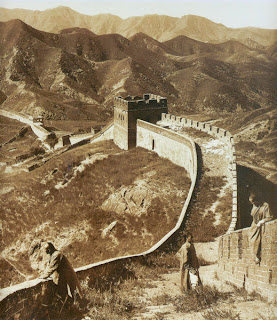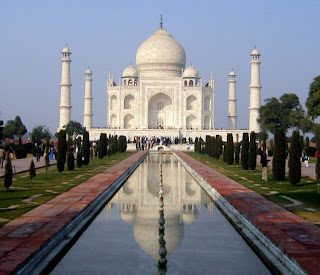There is one that I have climbed, one that is on my "To See" list, three that I have heard about and three that I have no knowledge about! So, I did some google-ing to increase and improve the file cabinet that I call my brain.
"Why did you refer to eight?" you may ask. Because the pyramids of Giza is the only one remaining from the original 7 wonders and maintained their "wonder" status. The Hanging Gardens of Babylon, the Statue of Zeus at Olympia, the Temple of Artemis at Ephesus, the Mausoleum of Halicarnassus, the Colossus of Rhodes and the Pharos lighthouse of Alexandria have all vanished.

Mexico's Chichen Itza pyramid:
Chichen Itza ("At the mouth of the well of the Itza") was built by the Maya civilization located in the northern center of the Yucatan Peninsula in present-day Mexico.
I started to include additional information (you can see it all by using the link above), but none of it felt right to me. This is the one that I have climbed - both the interior pyramid and the exterior. It was amazing! I have pictures that I took personally, but I do not have them digitally to share. :(

The Great Wall is the world's longest human-made structure, stretching over approximately 4,000 miles along an arc that roughly delineates the southern edge of Inner Mongolia.
This is the one on my "To See" list.
 Rome's Colosseum:
Rome's Colosseum:
This is the one on my "To See" list.
 Rome's Colosseum:
Rome's Colosseum:Originally capable of seating around 50,000 spectators, the Colosseum was used for gladiatorial contests and public spectacles. Although it is now in a severely ruined condition due to damage caused by earthquakes and stone-robbers, the Colosseum has long been seen as an iconic symbol of Imperial Rome and is one of the finest surviving examples of Roman architecture.

India's Taj Mahal:
The Taj Mahal (sometimes called "the Taj") is generally considered the finest example of Mughal architecture, a style that combines elements of Persian, Turkish, Indian and Islamic architectural styles. While the white domed marble mausoleum is the most familiar part of the monument, the Taj Mahal is actually an integrated complex of structures.

Peru's Machu Picchu:
Machu Picchu is probably the most familiar symbol of the Inca Empire. Often referred to as "The Lost City of the Incas". It is thought that the site was chosen for its unique location and geological features. It is said that the silhouette of the mountain range behind Machu Picchu represents the face of the Inca looking upward towards the sky, with the largest peak representing his pierced nose.

Jordan's Petra:
Petra is an archaeological site in Jordan, lying in a basin among the mountains which form the eastern flank of Arabah, the large valley running from the Dead Sea to the Gulf of Aqaba. It is famous for having many stone structures carved into the rock.


India's Taj Mahal:
The Taj Mahal (sometimes called "the Taj") is generally considered the finest example of Mughal architecture, a style that combines elements of Persian, Turkish, Indian and Islamic architectural styles. While the white domed marble mausoleum is the most familiar part of the monument, the Taj Mahal is actually an integrated complex of structures.

Peru's Machu Picchu:
Machu Picchu is probably the most familiar symbol of the Inca Empire. Often referred to as "The Lost City of the Incas". It is thought that the site was chosen for its unique location and geological features. It is said that the silhouette of the mountain range behind Machu Picchu represents the face of the Inca looking upward towards the sky, with the largest peak representing his pierced nose.

Jordan's Petra:
Petra is an archaeological site in Jordan, lying in a basin among the mountains which form the eastern flank of Arabah, the large valley running from the Dead Sea to the Gulf of Aqaba. It is famous for having many stone structures carved into the rock.

Brazil's Statue of Christ Redeemer:
Christ the Redeemer is a statue of Jesus Christ in Rio de Janeiro, Brazil. The statue stands 105 feet tall, weighs 700 tons and is located at the peak of the Corcovado mountain in the Tijuca Forest National Park, overlooking the city.
Christ the Redeemer is a statue of Jesus Christ in Rio de Janeiro, Brazil. The statue stands 105 feet tall, weighs 700 tons and is located at the peak of the Corcovado mountain in the Tijuca Forest National Park, overlooking the city.

The Pyramids of Giza:
The Great Pyramid of Giza is the oldest and the largest of the three pyramids in the Giza Necropolis bordering what is now Cairo, Egypt in Africa. The oldest and only remaining member of the Seven Wonders of the World, it is believed to have been constructed over a 20 year period concluding around 2560 BC.
*All info and pictures came from Wikipedia. Please see that site (Click on the name of the wonder to link to the appropriate site) for picture credits.
Namaste.
No comments:
Post a Comment